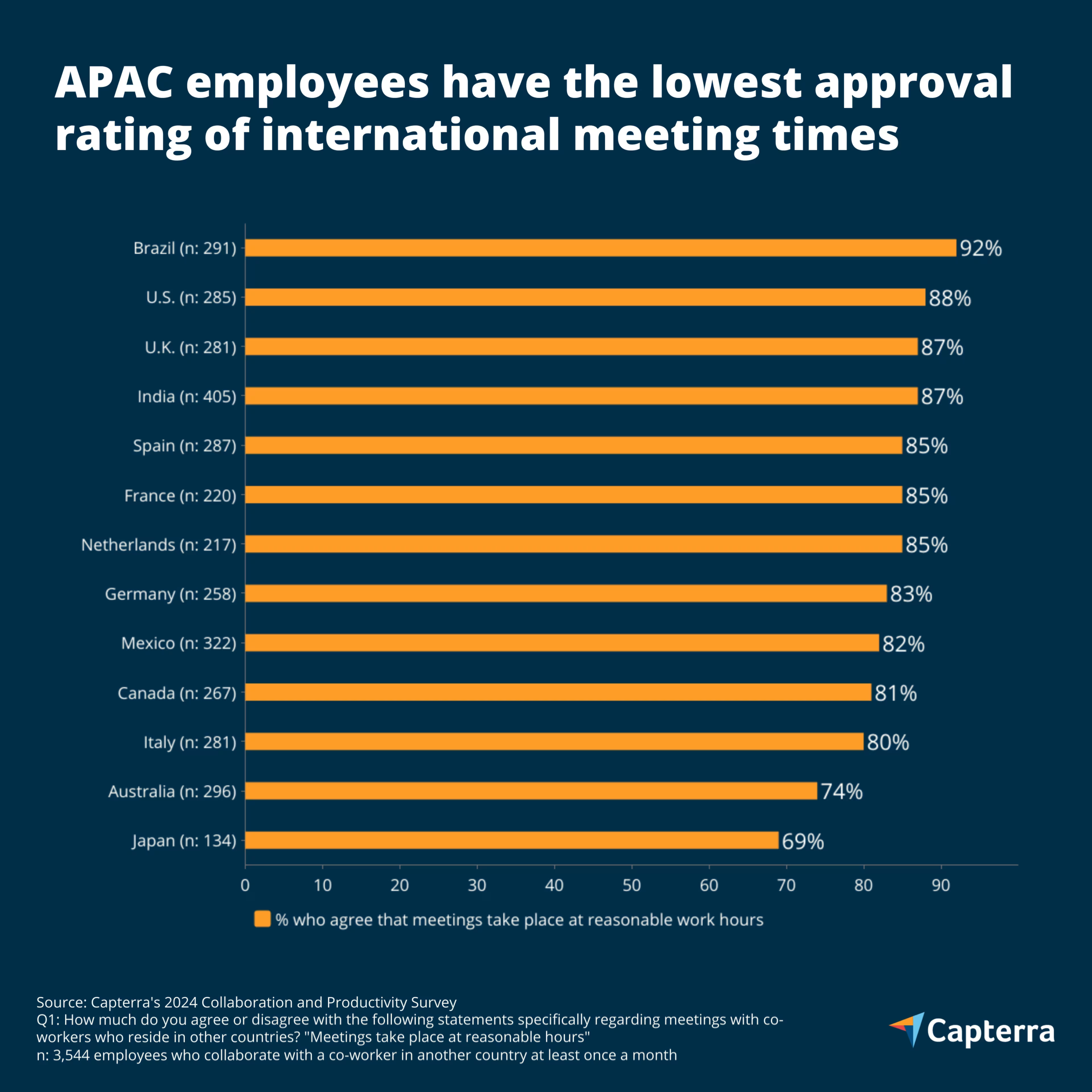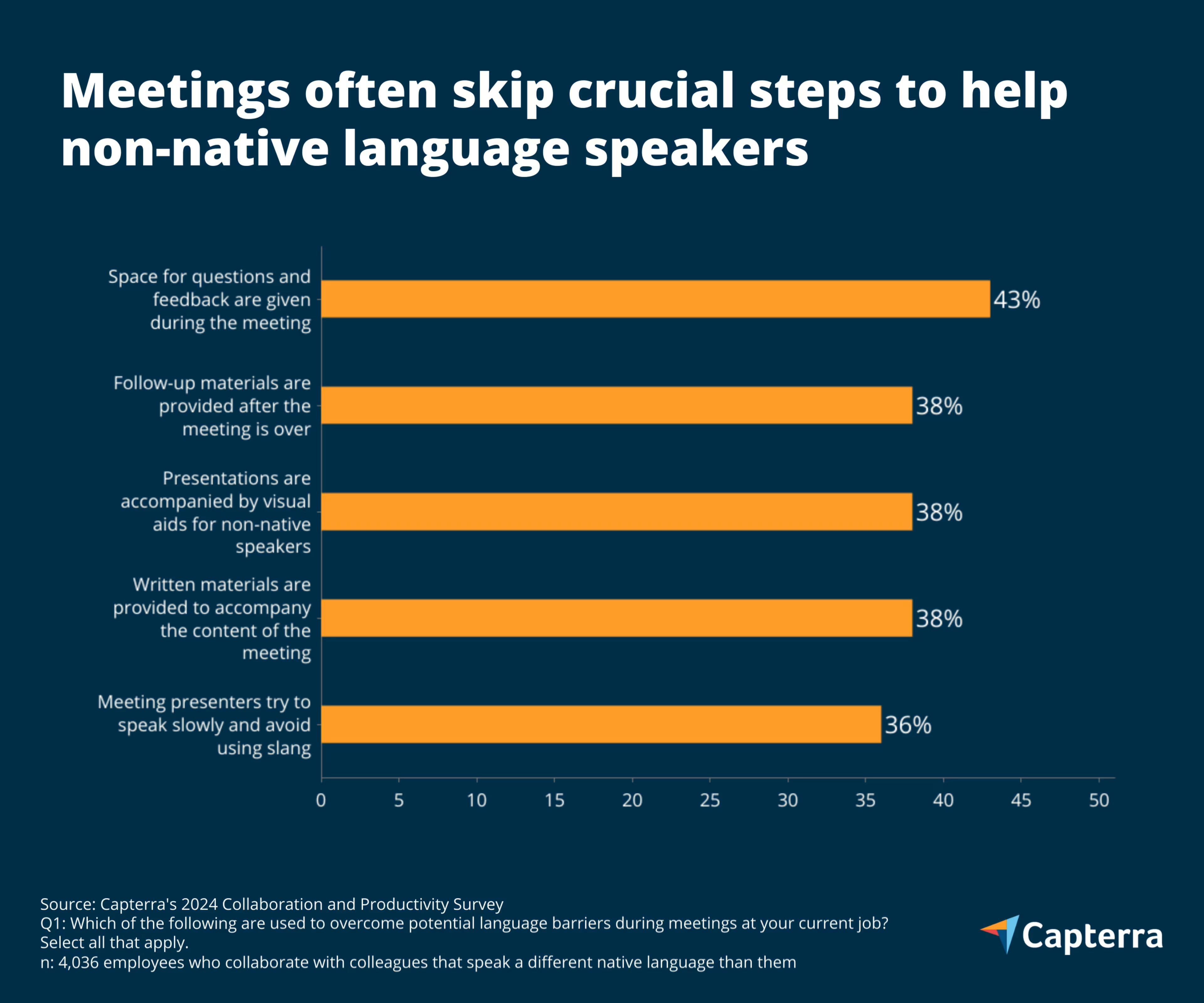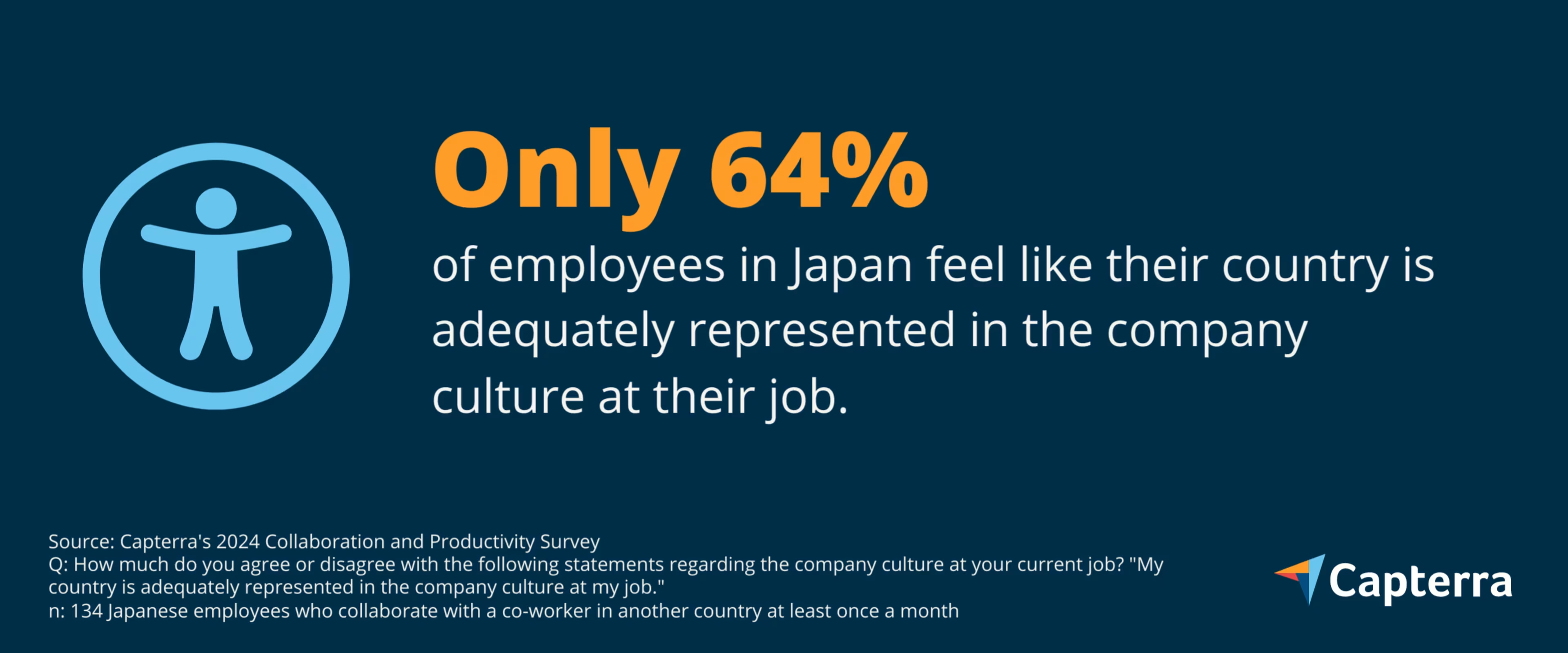59% of employees who collaborate with co-workers in other countries only started doing so less than two years ago.
The rise of remote work has, in turn, led to a rise in companies hiring talent abroad. Even small businesses now find themselves employing workers in multiple countries, presenting unique challenges when these workers need to come together (remotely) to achieve organizational goals.
To better understand these challenges—and to uncover solutions that HR leaders and project managers can use to deal with them—Capterra’s 2024 Collaboration and Productivity Survey collected nearly 6,500 responses from employees who collaborate across country lines around the world.*
Our results reveal that while most employees may be new to international collaboration, two-thirds still think it’s easy to maintain project timelines thanks to companies leveraging asynchronous collaboration tools and virtual meeting best practices. That being said, three “differences” that they cited are consistently inhibiting peak global team collaboration: differences in time, language, and culture.
/ Key findings
The top challenges when collaborating with co-workers in other countries according to employees who do so at least once a month are volatile work hours (44%), language barriers (42%), and cultural misunderstandings (33%).
While employees in the U.S. report the largest average time difference between them and a co-worker they regularly collaborate with (7 hours), employees in Japan and Australia are the ones least likely to say meetings take place at reasonable hours (69% and 74%, respectively).
Of the 62% of employees who work with colleagues who speak a different native language than them, only 38% say presentations are always accompanied by visual aids for non-native speakers, and only 36% say speakers in meetings try to speak slowly and avoid using slang or non-standard language.
Only 64% of employees in Japan feel like their country is adequately represented in the company culture at their job.
Time differences vary, but APAC feels put out the most
On many fronts, we find that companies are already doing the right things to support global team collaboration. Across all the employees in our survey that collaborate with someone in another country at least once a month:
86% agree their company uses software tools that enable effective international meetings.
84% agree that meetings have a clear agenda established ahead of time.
81% agree that summaries with key points are sent out after meetings.
As a result—and despite most employees starting to collaborate internationally less than two years ago—two-thirds (66%) say it’s “easy” or “very easy” to maintain project timelines when collaborating with co-workers in other countries.
This is no small feat, and credit is due to companies being forced to implement the right remote work tools and establish virtual meeting best practices during the COVID-19 pandemic.
However, that still leaves one in three workers struggling to maintain project timelines internationally. And one of the biggest factors affecting these employees are the time differences—just not in the way you might think.
For example, employees in the U.S. report the largest average time difference between them and someone they collaborate with internationally in our survey at 7.1 hours. Employees in Brazil, on the other hand, report the smallest average time difference at only 4.6 hours. One might assume from this that U.S. employees would be more unhappy with when meetings take place than those in Brazil. Instead, we find that workers in Brazil and the U.S. have the two highest likelihoods to say their meetings take place at reasonable hours (92% and 88% respectively).
We find no correlation between the length of time difference and the satisfaction level with when meetings take place. Rather, we find the highest dissatisfaction with when meetings take place is concentrated in one region: Asia-Pacific (APAC). Employees in Japan (69%) and Australia (74%) are the least likely to say that their meetings with international collaborators take place at reasonable hours.

Employees in Japan and Australia may not have the largest time difference to overcome, but they are often the ones stuck taking meetings at odd hours to collaborate with co-workers in the Americas and Europe—which can affect both their job satisfaction and their ability to focus and contribute.
If you have a sizable workforce in the APAC region, it may be beneficial to trade off when meetings take place and who has to work at odd hours. If you only have a few employees there, here are some other tips that can help without changing meeting times:
Be consistent: If you have a standing meeting with co-workers abroad, don’t move around what day of the week or what time it takes place unless absolutely necessary. Time zone converters can help ensure you set the meeting for the right time, and using Greenwich Mean Time (GMT) in communications about the meeting time can keep everyone on the same page.
Start and end meetings on time: If workers have to be up in the middle of the night to take a meeting, but it starts late and drags on past the expected duration, they’ll grow frustrated.
Understand when an email or instant message is better: APAC employees are among the most likely to say they have too many meetings in our survey. If you need to meet, make it count. And if what you need to accomplish can be done through an email chain or project management system, opt for that instead.
Technology is the ideal solution to deal with language barriers in meetings
Another major challenge with international collaboration is overcoming any language barriers. Sixty-two percent of the employees in our survey say they work on a team with colleagues who speak a different native language than their own, which can cause a disconnect when trying to collaborate.
This disconnect becomes most apparent in meetings. Of the employees on teams with colleagues who speak a different native language than them, less than half say meeting presenters provide visual aids or avoid using slang to help non-native speakers.

Providing materials and other aids to help convey information to employees who may not be super comfortable with the spoken language is critical in international collaboration. But creating all of this content—especially if it needs to be translated into multiple languages—can be time-consuming.
Software can help this process go faster. Translation tools that use neural machine translation (NMT) won’t produce a perfectly written translation, but they can help you get 90% of the way there very quickly. You can check out the Capterra Shortlist of the top translation tools on the market to find an NMT tool that works best for your needs and budget. Just make sure any translated copy is reviewed and edited by a native speaker prior to any meetings to ensure total accuracy.
There are also tools that can help translate during virtual meetings in real time. Microsoft, for example, added live translation to meeting captions in Microsoft Teams in 2022, and tools like Wordly can integrate with virtual meeting platforms and use artificial intelligence (AI) to translate words as they’re spoken.
Otherwise, it comes down to proper people management. Ensure international teams are trained on best practices such as not using slang and being sensitive to language differences on their teams.
How to incorporate contrasting collaboration styles into one company culture
The final challenge with global team collaboration, and perhaps the hardest to overcome, is dealing with cultural differences. Our survey results highlight just a few of the ways in which workers can approach collaboration differently depending on where they live:
82% of employees in the Netherlands prefer team bonding activities to be in-person, while 52% of employees in Japan prefer them to be virtual.
Most often, employees in Brazil believe the top goal of meetings is to plan, while those in the U.K. believe the top goal of meetings is to be productive.
87% of employees in India say their company culture directly affects how they work, compared to only 57% of employees in Mexico.
Overall, 86% of employees in our survey feel like their country is adequately represented in the company culture at their job, but this number drops as low as 64% among employees in Japan. Incorporating contrasting ideals into a cohesive company culture and collaboration style is difficult, and some employees may feel left out if they aren’t adequately represented.

If employees abroad don’t feel connected to your company culture, it could be a symptom of a lackluster diversity, equity, and inclusion (DEI) program. Companies have been increasing their investments in DEI in recent years, not just to diversify their workforce, but to ensure everyone is adequately represented throughout the organization.
If you’re unsure where to get started with your DEI program, employee resource groups (ERGs) are a cost-effective way to bring employees from similar backgrounds and cultures together to gather input on where your organization is failing to include them. We have tips for getting ERGs started at your company here.
Gartner offers additional advice on how you can make remote employees in different countries feel more engaged and connected to the company culture[1]:
Simplify what your culture is, and focus on its purpose: When companies are too dogmatic about what their culture should be, employees that fit outside of those norms will feel disengaged. Instead of being prescriptive (“this is the only way to do this”), your culture should be directional and driven by a shared purpose above all else.
Empower managers to create their own microcultures: Employees who work remotely may not feel connected to a large, monolithic company culture, but they do feel close to their team and their manager. That’s why managers should be encouraged to develop their own microcultures that use the organization’s primary cultural points, but adapt them to the unique needs and preferences of their teams.
Diagnose every employee’s desired level of connection: The serendipitous moments that connect workers in the office rarely happen when working remotely. To overcome this, HR leaders and managers should send out a survey to determine every employee’s level of need for connection (an example question: “How many hours per month are you willing to dedicate to grow your network?”). Using this data, managers can connect employees to the right virtual channels and events that meet their needs.
As international collaboration grows, overcoming these differences will be critical
Fifty-four percent of HR workers say their company operates in two or more countries.[2] As more companies expand their global footprint, the responsibility will fall on HR leaders and project managers to ensure that collaboration remains relatively seamless and fruitful.
For more on how to best support remote collaboration in the workplace, check out these additional resources:
